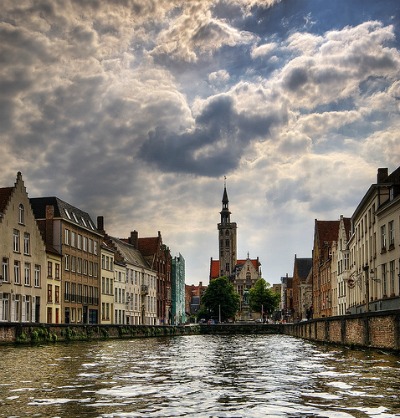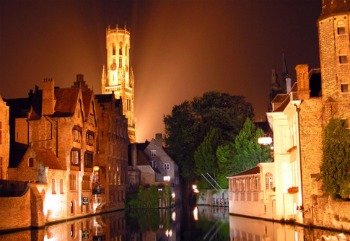Bruges
 Brussels may be the Belgian capital, but Bruges is probably the country’s most popular destination. The historic center is charming and gorgeous (so it’s no wonder that it’s a UNESCO World Heritage Site), and since it boasts canals like Amsterdam it also ranks pretty high on the romantic scale, too.
Brussels may be the Belgian capital, but Bruges is probably the country’s most popular destination. The historic center is charming and gorgeous (so it’s no wonder that it’s a UNESCO World Heritage Site), and since it boasts canals like Amsterdam it also ranks pretty high on the romantic scale, too.
For all its picturesque beauty, Bruges has one significant knock against it – the weather. It’s located in the far northwest of Belgium, not too far inland from the North Sea, so it’s prone to cold and damp weather. Summers are certainly more reliably pleasant, but even then the temperatures don’t usually get to “soaring.”
Because Bruges is relatively close to Amsterdam, it’s a logical next step after your visit to the Dutch capital (or vice versa, if you’re coming from Bruges and headed for Amsterdam). It’s not quite close enough to make it one a day trip from the other, but even if you opt for a train that requires two changes it’s still a not-very-stressful travel day.
How to Get to Bruges
The airport in Bruges is primarily a freight airport, so most people headed for the city fly into Brussels. In Brussels, you can choose between Brussels Airport (BRU) or Brussels South Charleroi Airport (CRL). The former is much closer to the city of Brussels, but since your objective is to get to Bruges then be sure to check both airports for price. South Charleroi Airport is smaller, but some of Europe’s budget airlines fly there instead of Brussels’ main airport, so you may find some good deals on flights.
Quick search for flights to Brussels Airport (BRU) and South Charleroi Airport (CRL):
var Company = “BNUS”;
var AgencyID = “”;
var Country = “US”;
var SubmitURL=”https://cart.railkey.com”;
ShowBookingWidget();
For most travelers who are already in Europe, the train is going to be the best option, being the best combination of cost and efficiency. If you’ve flown into Brussels, trains run between Brussels and Bruges roughly twice every hour during the day, and the trip itself takes about an hour. From Amsterdam to Bruges, the train trip ranges from 3.5-4 hours, depending on the route taken, and always requires at least one train change along the way.
More information:
Those on a driving tour of Europe will want to inquire about parking when they book their hotel in Bruges. The historic center isn’t designed for heavy car traffic and parking is extremely limited. Your best bet is to plan on parking outside the center and walking in from there, so make sure you ask your hotel for the best place to park the car before you drive to the city.
Bruges is a busy port, and if you’re coming from England and desperately love boats you can take a ferry to Belgium and then drive to Bruges. The closest ferry terminals are in Zeebrugge, Oostende, and Dunkirk.
Where to Stay in Bruges
 Bruges may be relatively small and its weather may be less than ideal most of the year, but that doesn’t stop it from being a very popular stop on many European tours. That means that if you’re visiting during the summer high season, you’ll want to book your stay well in advance or risk not finding a room in your price range.
Bruges may be relatively small and its weather may be less than ideal most of the year, but that doesn’t stop it from being a very popular stop on many European tours. That means that if you’re visiting during the summer high season, you’ll want to book your stay well in advance or risk not finding a room in your price range.
The good news is that the historic center is very compact and walkable, so if your hotel is in or near the center you’ll be able to walk just about anywhere you’d want to go. There are buses in the center if you don’t want to walk the whole time, and taking a canal cruise can be fun, too. Of course, properties in the historic center are more likely to be on the expensive side simply because of location, so check out places that are on the outskirts of the city center proper if you’re looking for deals.
In addition to the standard hotels in Bruges, the city also has a few hostels for more budget-minded travelers, and it’s a city that has several small B&B-style places, too. These can be good options if you’re on a budget but you’re not really into the hostel scene. Note that in order to appeal to a budget crowd, some of these B&Bs end up being listed under “hostels” rather than hotels, so don’t forget to search both categories when you’re looking for a room.
Anyone who’s planning to spend more than a few days in Bruges may want to look into a vacation rental – renting an apartment for a week or more can save money, and it’s especially convenient if you’re traveling with a family or another kind of group.
Quick search for hotels in Bruges:
What to Do & See in Bruges
 The city is certainly a main “sight” in Bruges, given its historic beauty, and the presence of the canals mean that canal cruises are almost always on the to-do list (except, of course, if the weather is truly dreadful). Other than simply wandering and sighing a lot, however, there are a few other things to do in Bruges, Belgium.
The city is certainly a main “sight” in Bruges, given its historic beauty, and the presence of the canals mean that canal cruises are almost always on the to-do list (except, of course, if the weather is truly dreadful). Other than simply wandering and sighing a lot, however, there are a few other things to do in Bruges, Belgium.
- Grote Markt – City’s main square, great for people-watching
- Belfry – Overlooking the Grote Markt, bell tower you can climb for great views (as seen in the movie “In Bruges”)
- Groeninge Museum – Art museum, mainly paintings, highlights artists who were born in or lived in Bruges
- Basilica of the Holy Blood (Heilige Bloed Basiliek) – On Burg Square, free to enter, home to a holy relic (as the name suggests) – a vial of what is said to be Jesus’ blood
- Church of Our Lady (Onze Lieve Vrouwkerk) – Medieval church, houses a Michelangelo sculpture of the Madonna & child
- Brewery Museum (Brewery De Halve Maan) – Beer museum, tours include history of Belgian beer making and one drink after the tour
- Choco-Story Museum – Chocolate museum
- The Friet Museum – “Fries” museum
When you get to Bruges, ask at the tourist information office about the Bruges Card – if you’ll be visiting enough of the attractions included on the card, it could save you quite a bit of money with discounts to those attractions.
photos, top to bottom, by: Wolfgang Staudt, Neilhooting, Wolfgang Staudt